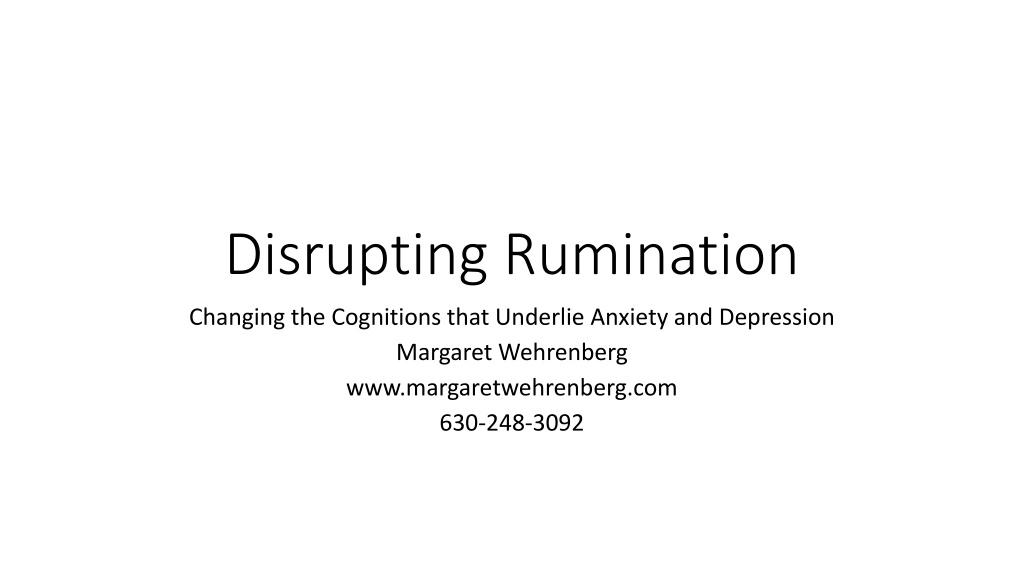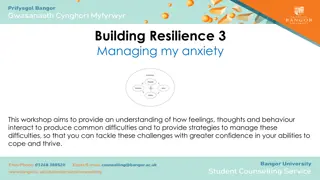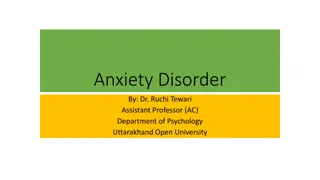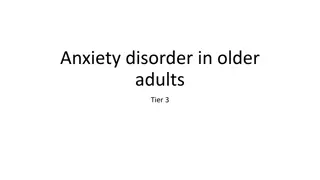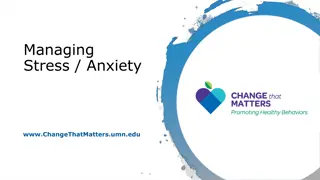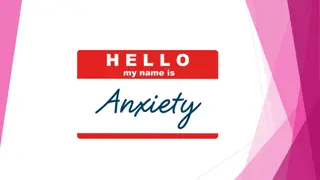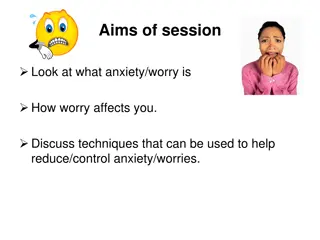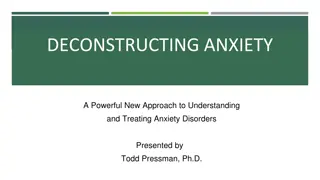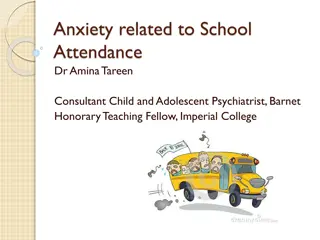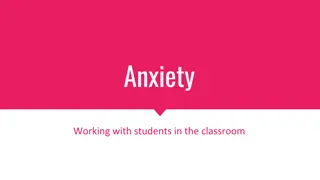Understanding and Managing Anxiety: Disrupting Rumination Patterns
Brain structure and function contribute to rumination, leading to anxiety and depression. Repetitive thinking strengthens neural pathways, reinforcing negativity. Anxiety arises from ambiguity, driving constant problem identification. Recognizing maladaptive worry behaviors is crucial for effective anxiety management.
Download Presentation

Please find below an Image/Link to download the presentation.
The content on the website is provided AS IS for your information and personal use only. It may not be sold, licensed, or shared on other websites without obtaining consent from the author. Download presentation by click this link. If you encounter any issues during the download, it is possible that the publisher has removed the file from their server.
E N D
Presentation Transcript
Disrupting Rumination Changing the Cognitions that Underlie Anxiety and Depression Margaret Wehrenberg www.margaretwehrenberg.com 630-248-3092
Brain Structure and Function Contribute to Rumination You can train people to worry but brain activity contributes to rumination: negative attention bias common to both Functional connectivity Rumination underlies at least one type of depression and is a feature of GAD It connects anxiety and depression
Repetition Strengthens Brain Activity One important principle is that repetition strengthens Ruminative thinking results in increased vascularization and more glial cell support makes worry path into worry super highway A.N.T.S. Automatic Negative Thoughts habitual thought patterns reinforce themselves and are later elicited by cues (moods, events, other thoughts) Interrupting rumination consistently and persistently quickly starts to erase the trace of worry
Repetition and Imagination When fears that are repetitively imagined the pathways are strengthened, sensitizing the responses to cues objective or perceived Negative anticipation creates higher likelihood of perceiving negativity Brain function in anxiety/depression geared to notice negativity self-reinforcing
Why Worry? The sensation of anxiety is the human response to ambiguity It drives you in the direction of problem identification and solution When the sensation of anxiety exists without cause, the brain goes on a search for problems Worry: maladaptive attempt to resolve anxiety, worsening it in the absence of a real problem
Anxiety: condition looking for content Anxiety sensation precedes scanning the environment for cause usually a cause is found People seek relief by seeking reassurance: Internet searching is becoming a major source of anxiety-increasing reassurance-seeking. If the anxiety can be de-bunked or it becomes obvious the worry is not going to happen, relief is brief.
Correct Cognitive Mis-Steps If it is possible, anxiety leads to thinking and behaving as if it is probable teach the distinction between these If you can make a plan, it is a real problem with a real solution. Then planning solves the problem of worry too. (Teach Planning!) If you cannot make a plan it is a worry. Use worry- elimination strategies.
Guilt is Excellent Content for Anxiety Guilt is excellent content. So: Need to resolve guilt BUT without falling into reassurance trap. Potential guilt: something you maybe did wrong or possible negative outcome of an action Use thought stopping/thought replacing
Legitimate Guilt Legitimate Guilt 1. Write down what you did wrong 2. Talk it over with someone safe 3. Decide what will make restitution 4. Make restitution
Erase the Trace of Ruminative Thought Thought Stopping - Thought Replacement Always planned, used consistently: Sing Two-P method (Pleasant/Productive) thought replacement list has relevance and novelty Re-focus on work or people around you Be prepared with an inspirational/positive thought to recite
Handling Magical Worry Worry can have 4 unrecognized functions Without worry, people believe they will fail to be careful. Remind them that caution can be a 1-time decision they won t forget It may be a protection to ward off bad things, e.g., If I worry about this it won t happen. bring to awareness. Use thought stopping. It may be center of a relationship or identity develop an image of life without anxiety It may be important worry without a resolution decide to suppress it
Neural Networks Affect Depression Memory is stored in networks Networks connected by affect, time Neural constructs affect consequent interpretation of life experience and categorization of memory Changing Depression means attention to neural networks
Neural Networks Tap Similar Emotions and Patterns of Thought We react to our moods mood brings back affective or cognitive memory of conditions when mood was created: mood worsens, network enhanced Interpretations go to core themes of inadequacy and worthlessness
Endogenous Depression Born to Be Blue Low Activation from neurotransmitters and inability to slow/stop rumination Impact from structural features in orbitofrontal cortex, amygdala, connectivity between prefrontal cortex- anterior cingulate cortex and amygdala, etc., contribute to ruminative tendencies Difficulties processing information
Purposefully Change the Network Plan to have better things to do Don t worry until it happens Visualize things working out Help people give you what you want/need Visualize yourself responding resiliently to a situation
Prime the Pump/Start the Train Rolling Commit to small amounts of time on tasks that have no definable components like filing, sorting mail, outside work Identify and use rewards already in place as reward for completing components of a larger task (e.g., doing laundry) Time tasks that seem big reality check
Chronic Situational Stressors Chronic activation of H-P-A (hypothalamus pituitary- adrenal axis) = excess of adrenalin and cortisol = dose-specific to severity/length/sense of control over stressor a) Neurotransmitters depleted especially the balance that helps turn off stress b) Stress interferes with capacity to perceive the detrimental impact of the stressor
Respond Differently to Situation-Induced Depression Improve self care immediately Ask for help from others even if it is just to ask what they would do in your situation to handle with less impact on your health Change Your Explanatory Style Feelings of being bereft can be helped with reconnecting to something greater than yourself - rejoin groups for spiritual or community connection
Mobilize Your Energy Mobilizing is critical to intervening on lethargy, which affects all three arenas. Confront I can t. Ask your client simply to say I won t! whenever you hear I can t. Ironically, making the verbal refusal of I will not is an act of power, not the helplessness of I can t. In say won t a feeling of control enters in . Change I have to to I choose to. (Legitimate) perception of choice to do what is not pleasing increases sense of control
Interrupt Helplessness Neural Network Notice Without Judging 1) choose to remember that your emotional reactions are your interpretation of a situation or communication 2) observe: what is happening in the situation and what sensations are you experiencing? 3) suspend judgment of why it is happening 4) focus on what possible responses will help you.
Focus On Strength: I Do What I Am What I do changes how I feel about myself Opportunities to do what we are good at creates genuine self-esteem. Depressed clients forget they have strengths and positives. Work on this in therapy sessions: 1. Make a list of your best strengths, e.g., Hard worker, honest, kind, creative, disciplined 2. Make a list of opportunities to use your strengths 3. Each day, note: did I use my strengths? How?
Tracking Strengths example chart STRENGTH kindness Monday s meeting STRENGTH discipline Tired: Got work done STRENGTH curiosity Put shelf together STRENGTH loyalty Talk with girlfriend USED IN USED IN USED IN USED IN
Impact of Early Life Adversity Early life experiences of neglect, abuse, problematic attachment, depressed mothers poor self-soothing later in life increased CRF in response to stress no molehills Plunges into despair - hopelessness Dose-response: more adversity = more difficulty with mental and physical health May alter structures, may create limited capacity to categorize new experiences
Pre-Trigger Preparation for Connection Major goal is to stop the slide to despair with planned-ahead strategies Set up obligations that you must attend Find a resource group such as 12 step calling someone on your list is good trigger-response Use inspirational apps daily Create coping cards and carry them in notes or utilize apps such as Mindshift, SAMapp, and others
Increase Positive Experiences Access to positive experience is blocked by depression - causes avoidance of contact with positive experience. First, increase awareness of positive experience Track daily activities very specifically: Write down what you are doing. Then answer, Is it Pleasurable or Unpleasurable? (If pleasurable, rate the degree of pleasure) Answer, Did I accomplish something? (If yes, rate the degree of accomplishment) Notice what is already working
Change Your Explanatory Style Notice negative storylines Change your explanation about why it s happening. 1. Dispute negative and limiting thoughts: What is the evidence? 2. Find alternative causes for bad events. 3. Consider less catastrophic implications Will this really ruin my life? 4. Plan how to improve the situation.
Gratitude Assignments 1. Attitude of Gratitude A.A. 2. Gratitude journal (Emmons and Lyobormisky) 3 blessings a day or each week journaling on the blessings Daily is more effective 3. Daily write 3 things that went well and what you did to make them happen Increases memory of positives and self efficacy 4. Gratitude Visits with Testimonials (Seligman)
